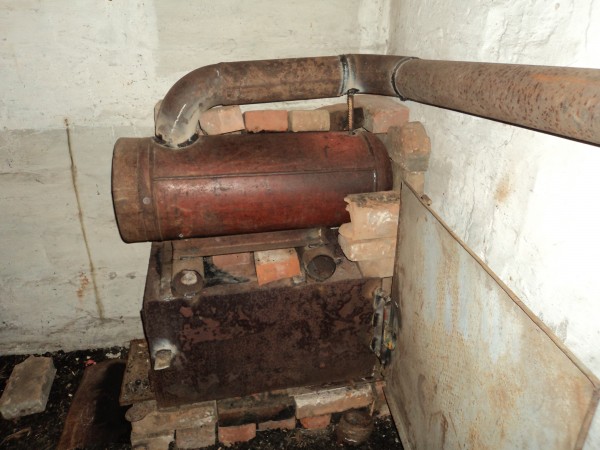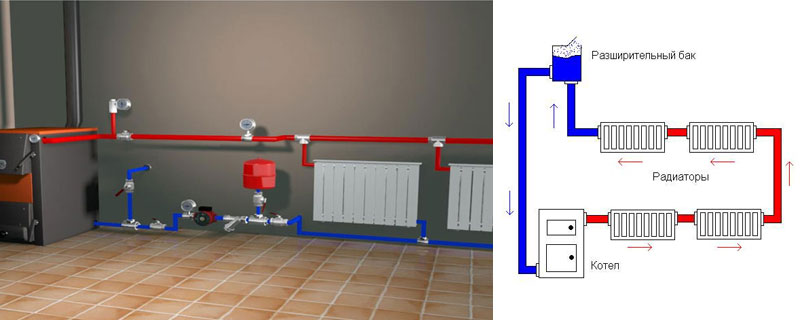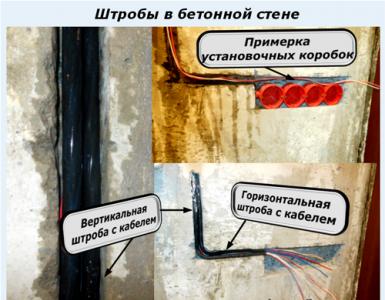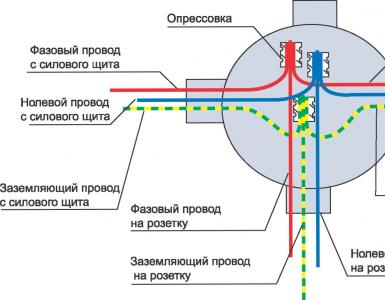Homemade garage heating: how to do it yourself simply, economically and safely?
How to organize garage heating with your own hands? What is the best way to heat a garage in winter? How to cheaply make a garage warm? Let's try to answer these questions later in the article and figure out which ones are better to use.
Garage heating options
The easiest way to heat the garage, which is located in the same building as a residential building or close to it. In this case, buildings are most advantageously heated by a common system. Most often it is a water system with a gas boiler.
With a significant removal of the garage will have to heat it independently. When choosing a method, car owners most often take into account the type of fuel, cost, safety, complexity or ease of installation of heating equipment.
And so, how to make heating in the garage with your own hands? Do-it-yourself garage heating: cheap and fast (the most economical way) - is it real?
Gas heaters
Gas- one of the cheapest types of fuel, and the equipment needed to heat the garage can be easily found on the market.
Natural gas can be the basis for:
- a full-fledged heating system with a gas boiler that heats the water that circulates in the pipes;
- heating with a heat gun, in which the gas burns in a special burner, and the heat is distributed with the help of a fan;
- using a catalytic or infrared gas heater, where the gas burns in ceramic honeycombs, and the heat spreads throughout the room.
For the first option it is necessary to connect to the main gas pipeline, which is carried out by employees of the gas service only after signing a number of documents and paying the cost of the tie-in.
This option for using gas is the most difficult: it takes time to prepare documents, design and install a heating system, purchase and install a boiler. The costs will pay off only with the constant heating of a large capital garage.
Second and third options are easier to use and do not require special permissions. For their implementation, you can use liquefied gas from cylinders.
According to fire safety standards, the gas cylinder must be in a closed metal box away from the heating element.
Of course, when using this type of heating, you will have to invest in special equipment, but the low cost of fuel will pay off these costs over time. The main disadvantage of using a gas heat gun and gas burners is that the combustion products remain in the room and it must be ventilated frequently.
Furnaces for mining
This method is often used in car repair shops, but it is also suitable for a private garage. You can make a heater with your own hands from an oil tank (which can be a gas cylinder with a cut off top) and a metal pipe about a meter long.
With the right design, it is safer than a household gas stove, and the oil in it burns out completely, leaving no soot and soot. In practice, such structures in need of cleansing from soot and soot at least once a week.
Another minus construction - the oil is ignited through the blower with the help of a torch and does not always light up the first time - it is unlikely that it will be possible to quickly kindle such a stove with chilled hands.
Oil used for heating must not contain combustible impurities: acetone, gasoline, etc., otherwise the tank will explode.
Based on the incineration furnace you can make a complete system with pipes and radiators. To do this, a boiler is placed on the furnace with an outlet for the water pipe and an inlet for the return, and pipes are placed in the room.
Heating with waste oil one of the safest(oil vapors burn in the pipe and ignition of objects surrounding the boiler is excluded) and economical methods (used waste product is used as fuel).
minus heating with used oil is the difficulty of installing the furnace - the length of the chimney should be about 4 m. and it is installed with a constant upward slope.
Boilers for solid and diesel fuel
 A small one will do an excellent job of heating a small room and at the same time dry the air. You can burn it coal, firewood, peat briquettes, etc.
A small one will do an excellent job of heating a small room and at the same time dry the air. You can burn it coal, firewood, peat briquettes, etc.
Instead of a homemade potbelly stove you can use a special boiler, but then the amount of its cost will be added to the cost estimate.
There are boilers for solid and diesel fuel. They are safe and do not require the constant presence of a person.
Some car owners install in garages brick ovens. The principle of operation of the stove is similar to that of a potbelly stove - when burned, the fuel heats the stove, from which the air in the room warms up. The difference between a brick stove and an iron stove is in the heating rate: the brick heats up longer, but it also retains heat better.
When installing a boiler or potbelly stove fire safety regulations must be taken into account: install the stove on a solid (preferably monolithic) non-combustible base, protect nearby surfaces from accidental ignition and properly equip the chimney.
Using a potbelly stove or brick oven is suitable for temporary garage heating- it is impossible to automate the supply of fuel, and it is inconvenient to constantly add firewood or coal. Another serious drawback of this option is the high fire hazard. Even with equipment around an iron apron, there is a risk of igniting fuel, rubber or other materials that are always in the garage.
Safe to use oven "Buleryan". They heat it with firewood, which is laid once every 5-10 hours. The disadvantage of such a stove is its cost, the complexity of arranging the chimney - it must be properly insulated, and the need for regular removal of soot.
General minus the use of the listed furnaces - the need to purchase fuel and equipment for storage space.
In addition, the factory boilers are expensive, and homemade potbelly stoves and brick stoves can cause a fire.

Circulating hot water system
Water heating- one of the most reliable and safe, but it is more suitable for large garages in which you need to maintain the temperature of several rooms.
For system device pipes are needed through which hot water will circulate, heating radiators that increase heat transfer and a boiler: gas, electric, for solid or liquid fuels. The complexity of the work and the cost of acquiring equipment will not pay off when used in a small room.
With electric boiler there are fewer problems, but you will have to regularly pay high electricity bills, and in the event of an accident on the power line, there is a possibility of water freezing in the system. The option is not suitable for regions with a predominance of strong winds and snowy winters: these phenomena can break the wires and, if you do not have time to drain the water from the system, you will have to change the burst pipes.
You can heat the water in the boiler, as mentioned above, on a stove that burns waste oil or on an ordinary potbelly stove. Such a system heats the room more slowly than a heat gun or convector, but it also retains heat longer.
You can lower the freezing point of water by adding special liquids to it, the most common of which is antifreeze. Their use will slow down the formation of ice in the pipes, but in case of severe frost and a break in heating for more than a day or two, it is better to drain the water.
With frequent draining of water, iron pipes and radiators can rust. This can be avoided by using modern, metal-plastic equipment. For the same reason, it is undesirable to use old, previously used radiators - dust and rust can accumulate inside them, which will cause blockage of the system and disruption of water circulation.
Advantage systems with liquid circulating through pipes in uniform heating of the room and keeping heat for several hours after the end of heating.
Minus- in the complexity and price of the arrangement, the need to drain the water in the event of a heating cessation for several days.

Electricity
Heating with electricity is the ideal way to heat a garage without wasting time installing and installing the system. Today there is four options:
- heat guns(the cheapest option) - hot air flows out and spreads in all directions, thanks to a fan placed inside the device;
- infrared heaters for a garage (the average cost method) they do not heat the air, but objects and surfaces, which in turn radiate heat. This method requires less electricity than a heat gun or convector. Infra-red rays are absolutely safe for humans, but can damage car paint. It is best if the rays are directed at the garage door - this will create a thermal curtain and allow you to heat the room more economically;
- convector(more expensive than the first two options) heats up itself and spreads heat around itself. Heats the room more slowly than a cannon, but its heat remains a little longer after turning it off. There are various models of convectors on the market - equipped with wheels for moving, installed in one place or mounted on the wall;
- inverter split systems(air conditioning systems are the most expensive way) allow you to maintain a constant temperature, save electricity, operate at temperatures up to -20 degrees. The main disadvantage is the high cost.
To use any electric heater, you must be sure of the quality of the garage wiring - it will endure significant loads. In addition, it is dangerous to leave these heaters unattended for a long time.
Disadvantages of heating with electricity is the high cost of equipment and consumed electricity, the possibility of a short circuit on an overloaded power line and dependence on the supply of electricity (if the wires break in the garage, it will not only be dark, but also cold).
Useful video
Video on how to make heating in the garage with your own hands.
Do-it-yourself garage heating: cheap and fast (the most economical way).
The choice of heating method depends on many factors.: the size of the garage, the type of building - permanent or temporary, you constantly need to maintain the temperature or you need to be able to quickly warm up the room, etc. Only by answering all the questions, the motorist will be able to make the right choice, because each heating method has advantages.
So a heat gun or a heater on wheels does not require installation, a potbelly stove device will cost the cheapest, you can save on fuel by heating the garage with used oil.
Wherein the safest options- these are factory boilers for heating with solid or diesel fuel, and a system with a liquid circulating through pipes, heated by a gas boiler, can provide temperature constancy.













